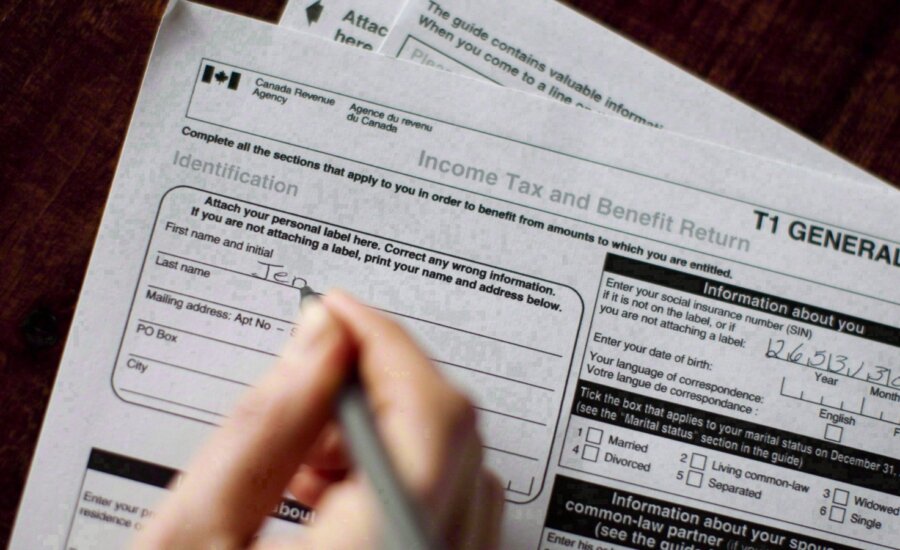Tax changes to know about for 2023, from home offices to house flipping
Let’s review the big changes to be aware of this tax filing season.
Advertisement
Let’s review the big changes to be aware of this tax filing season.

Taxes may well be a certainty of life, but they can morph and multiply by the year, including some big changes this filing season.
Here are the new rules you should know about:
Throughout the COVID-19 pandemic, workers could deduct $2 a day from their taxable earnings for each day worked from home, up to a maximum of $500. That “temporary flat rate” no longer applies.
When filing for 2023, employees can only deduct home office expenses if they were required—not simply allowed—to work from home more than half the time for at least a month straight. And they need a form called the T2200 signed and handed over by their employer to do so.
“You’ve got to add up all your expenses, whether it’s utilities or repairs and all the rest, and then claim a portion of those based on the square footage of your office as a percentage of your entire home,” said Tim Cestnick, a tax and personal finance expert.
Deadlines, tax tips and more
The interest rate on overdue income taxes has risen to 10% from 9%.
“It can be a pretty big hit for people,” said Nicole Ewing, director of tax and estate planning at TD Wealth. “File and pay as early as you can to avoid any of that.”
Experts recommend filing on time—the deadline is April 30—even if you know you can’t immediately fork over the money, in order to avoid late penalties.
“You might even be better off borrowing money from the bank or borrowing on a line of credit to pay your taxes, because that rate’s probably lower than what the CRA is charging on overdue taxes,” said Cestnick.
As of last April, Canadians who have not owned a home for at least four years can make contributions of up to $8,000 annually to the first home savings account (FHSA), with a total cap of $40,000.
Money socked away here is tax-deductible, and the income earned inside the registered plan will not be taxed either, including when it’s withdrawn to put toward a house or condo.
However, unlike with a tax-free savings account (TFSA) or a registered retirement savings plan (RRSP), the carry-forward limit maxes out quickly.
“So if you open an FHSA, make no contributions to it for 10 years, you have carry-forward room of $8,000; you have not accrued $40,000 of carry-forward room,” Ewing said.
“In year 11, for example, you can make your $8,000 contribution, plus $8,000 of carry-forward.”
Moreover, the FHSA currently has a 15-year time limit, after which the funds can be transferred to an RRSP or withdrawn as taxable income, if it’s not used to buy a home.

Get up to 4.00% interest on your savings without any fees.

Lock in your deposit and earn a guaranteed interest rate of 3.55%.

Earn 3.7% for 7 months on eligible deposits up to $500k. Offer ends June 30, 2025.
MoneySense is an award-winning magazine, helping Canadians navigate money matters since 1999. Our editorial team of trained journalists works closely with leading personal finance experts in Canada. To help you find the best financial products, we compare the offerings from over 12 major institutions, including banks, credit unions and card issuers. Learn more about our advertising and trusted partners.
With housing an increasingly scarce resource, the Multigenerational Home Renovation Tax Credit aims to ease the cost of establishing a secondary unit.
“Perhaps your parents are moving in with you and you’re caring for them and making room in your home … that is where the tax credit can be relevant,” said Ewing. Family members aged 18 or over who are dependent—from nieces to aunts—also count.
The credit lets home owners claim 15% of the renovation cost up to a maximum of $50,000, potentially allowing them to subtract as much as $7,500 from their income tax.
However, the mother-in-law suite must be self-contained.
“It has to have its own entrance, its own kitchen, bathroom, sleeping area,” noted Cestnick. “You can’t just sort of carve up one room of the house and then renovate it and claim the tax credit.”
As of Jan. 1, profits from the sale of residential properties owned for less than a year are taxed as business income, rather than treated as a tax-free capital gain if it’s your primary residence.
“The government’s been concerned about people who are buying, fixing up and flipping properties. For many years people have been kind of abusing the rules and calling these properties their principal residences and really not paying any tax,” Cestnick said.
However, there are some key exceptions.
“The government doesn’t want a rule like this to require people to stay in bad marriages or to stay with somebody if there’s a threat of domestic violence,” Ewing said. A death, illness or disability might also allow for a sale soon after purchase that would be exempt from taxation.
The reporting rules around trusts have expanded to include taxpayers who didn’t have to note them on their returns before.
Trustees who are part of so-called bare trusts—where a trustee holds title to a property or other asset but has no other powers, all of which are held by the beneficiary—must now file tax information in a lengthy Schedule 15 form by April 2 (not April 30).
“Let’s say you open up an investment account for a minor child, a grandchild or a child,” said Cestnick. “The government is saying, that’s a trust arrangement and now you need to file a tax return for that trust arrangement”—if the account holds $50,000 or more.
A house where the parent’s name is on the title of a home owned by their child—who perhaps couldn’t qualify for a mortgage without Mom’s backing—would likely count as well, he said.
“It’s not clear who needs to file and in what situations,” Cestnick added. “There are a lot of situations where it’s a grey area.”
John Oakey, vice-president of tax at CPA Canada, advised taxpayers who think they might be in a trust position to consult with a professional.
Employees in the trades can now deduct twice the amount of their tool-related costs: $1,000 versus $500 the previous year.
While a welcome move, it might not make a significant difference.
“They have to pay for their own tools quite often,” Cestnick said of tradespeople. “It’ll help a little bit.”
“But if you spend $1,000 on tools, you might get back $300 or maybe $350 when you claim the deduction for those things,” he said, assuming an annual income of around $100,000.
Share this article Share on Facebook Share on Twitter Share on Linkedin Share on Reddit Share on Email
This article said the Schedule 15 is “lengthy’. However, I downloaded the Schedule 15 and it is only 2 pages long. However, the T3 Trust Income Tax and Information Return is longer, at 5 pages.
Was the article an error and did you actually mean the T3 Trust Income Tax and Information Return is lengthy?
I just submitted my Bare Trust docs. The T3 Trust Income Tax and Information Return only requires the Trustee (and only the Trustee) to complete Section 1 and the Certification at the end of this form, so is not as onerous as it appears. Both the Trustee and Settlor must complete a Schedule 15. My difficulty was in ascertaining exactly what was required. Once that was clear,( after three phone calls to CRA), the rest was straightforward. Another complaint I have was that I only found out about this new tax reporting rule by accident, as it was the topic in Rob Carrick’s column in the Globe and Mail a couple of weeks ago. Otherwise, I might not have known about it in time to get all documents submitted when required.